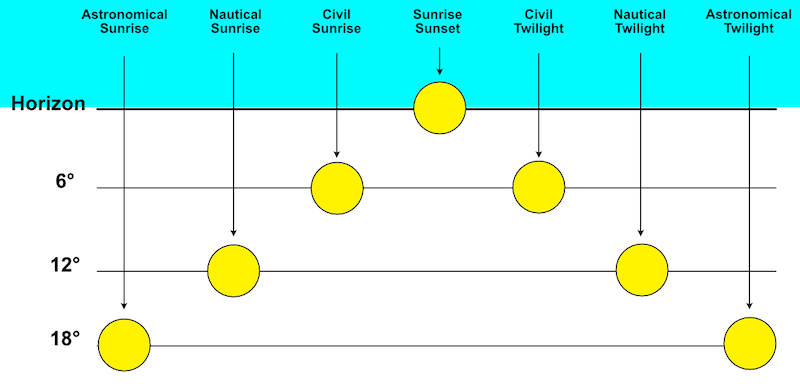Sunrise, Sunset
There’s more to the sun’s arrival and departure each day than most of us realize.

There’s more to the sun’s arrival and departure than we realize.
Most of us are familiar with the usual definition of sunrise and sunset—the sun appears each morning and disappears each evening. From an astronomical standpoint, however, there’s more to it than appears at first blush.
Sunrise and sunset are actually divided into four distinct phases. Each phase is defined by the position of the geometric center of the sun’s disk relative to the horizon. As seen in the accompanying diagram, there are four markers that determine which phase the sun is in.
The first phase of sunrise occurs when the sun is 18° to 12° below the horizon. This is astronomical sunrise. During this phase, the first glow of light appears in the eastern sky.
The next phase is nautical sunrise when the sun’s center is between 12° and 6° below the horizon. During this lighter phase, the horizon is discernible in clear weather and the stars are still visible, allowing sailors to still navigate by the stars, hence the name.
This is followed by civil sunrise when the sun is between 6° below the horizon and the horizon. During this period, most objects can be easily discerned without the aid of artificial lighting. This is the period that most people are familiar with when they think of dawn.
Finally, there is sunrise itself, when the sun’s geometric center breaks the horizon.
The reverse happens when the sun begins to set. Sunset occurs when the geometric center of the sun’s disk hits the horizon. Civil twilight occurs when the sun is between the horizon and 6° below the horizon. During this period there is usually plenty of light for outdoor activities such as sports to continue without the need for lighting.
This is followed by nautical twilight when the sun is between 6° and 12° below the horizon. During clear weather, the horizon is still visible and stars begin to appear allowing sailors to navigate.
Finally, there is astronomical twilight when the sun is between 12° and 18° below the horizon. Stars are readily visible in clear weather. Once the sun’s disk goes below 18°, that is considered nighttime, or full dark.
These various distinctions are especially important to photographers, who consider the period just before and after sunset or sunrise the best lighting for landscape photography. The golden hour is between 30 minutes before and 30 minutes after sunset, when oranges and reds are most prominent in the evening sky. The blue hour is between ten and twenty minutes following the golden hour, noted for the blue cast of its light. Similar distinctions are made around sunrise.
If you want to know exactly when these periods are occurring at your location try Photopills, an app for iOS and Android, which functions as a widget on your phone and gives accurate times for sunrise and sunset events. Another excellent program is Photo Ephemeris, where a unique map allows you to see the times for astronomical events and see the location and elevation of the sun or moon at any time during the day.
